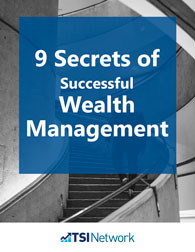Topic: Wealth Management
Pat McKeough's investment ideas as shown on YouTube: Part 2
As the stock market rebounded in 2009 from one of the worst crises in years, Pat McKeough was invited by Jonathan Chevreau of the Financial Post to appear on his ‘Wealthy Boomer’ telecast. In a two-part interview, Pat aired his views on a wide variety of investment subjects.
Now, with the stock market coming off last autumn’s lows, we think it’s an appropriate time to replay the interview. Pat discusses not only specific solutions for volatile markets, but also how his investment advice applies in all market conditions. Here is part two of the interview, entitled “Spreading investments” on YouTube. (View part one here: Pat McKeough’s investment ideas as shown on YouTube.)
Below is the transcription of part two of the interview.
Wealthy Boomer Interview Part 2
JC: Welcome to the second interview with Patrick McKeough, the publisher of the Wall Street Stock Forecaster, The Successful Investor, and recently has created the website tsinetwork.ca, which is also the Successful Investor. Welcome back, Pat.
PM: Thank you, Jon.
JC: I thought we’d discuss this: Fortune Magazine recently had an issue in which they focused on the forty stocks to retire on. It struck me that many of them are U.S.-based multinationals. In fact, some of them are probably Dow stocks. First, I wanted to ask, what do you think of just buying the whole Dow, all thirty through Diamonds [an exchange-traded fund, symbol DIA, that seeks to mirror the performance of the top 30 Dow stocks—Ed.]. In Canada, recently, BMO announced a sort of Diamond hedged back into Canadian currency. In either of those, I’m sure there are a number of them that you wouldn’t want to own.
PM: Well, I prefer to have a portfolio that—as you know—I’m constantly going on about our three key criteria, good quality investments, diversified across the five sectors, and that aren’t all in the limelight. That aren’t all things you read about every day in the media. I think you’re better off to concentrate—it’s essential to stick with good, well-established, healthy companies, like Fortune’s done there. But I think you need the diversification as well. Because there’s one precedent you might think back to.
At the end of the 60s, or early 70s, you might have heard the term, the “nifty fifty.” Those were the 50 stocks that everybody in the pension world agreed you couldn’t go wrong buying these stocks. They were one-decision stocks, meaning, when do you buy them? Then you just ride them off to infinity. And all that changed in ‘73-74 when all these one-decision stocks collapsed. So, if you’re thinking you can buy something and hold it forever, you’re at risk of having a big holding in the next crop of one-decision stocks, or the next “nifty fifty,” or nifty forty, that will suddenly go out of favour, all at once.
JC: Are you a subscriber to the “Dogs of the Dow” theory where you just pick off the high-yielding ones? I know stocks like Verizon and GE and AT&T are all paying decent dividends, even after the cut. What do you think about “Dogs of the Dow?”
PM: Well, I think any kind of rule can give you good results in some particular time period. But to the extent that it gives you really good results in one time period, it can go wrong in another time period. There’s an old expression, or saying, that high yield may be a danger sign rather than a bargain. And that’s the constant risk you’re faced with, with the kind of stock picking rule that puts too much weight on a single factor, namely, dividend yields.
So, I prefer to build a portfolio of diversified, well-established companies. You’ll have a variety of yields in there. Some things will yield 1%, some will yield 5%. But I think you’re better off doing that because the results may not be better in a good year, but I think they will tend to be better in a bad year.
JC: OK, I have one analysis here in that Fortune article. Now, they picked out three of them: Coke, Johnson and Johnson, and Proctor and Gamble—and McDonald’s—actually, the four. Any thoughts on any of those? Any of those happen to be your own recommendations at The Successful Investor?
PM: Two of them are. McDonald’s, I like, and Proctor and Gamble, I like. McDonald’s seems to be really good at anticipating trends, and catering its menu in a given country to what people want in that country. By the same token, Proctor and Gamble has got a wide consumer products range and a great distribution team, and so on. Whereas Coke—you know it’s not exactly comparable, but at one time, cigarette companies were just unbeatable. They were in the nifty fifty. And then things changed, and people didn’t want cigarettes any more. Well, is it inconceivable that something like that will happen with Coke? It’s not very likely to happen THIS year, but it’s certainly not inconceivable.
JC: Certainly, some people prefer PepsiCo because they have a little more diversity, you know, Frito Lay and a bunch of junk food surrounding it.
PM: And that’s our pick, incidentally, in that area.
JC: (laugh) Well, now I know! But beyond the Dow 30, is there a second tier which is not so much… the problem with the Dow is they’re all, as you say, in the limelight. But, on the other hand, the valuations of these stocks compared to 1999 are way down, in the low teens instead of 20, 30, 40 p/e ratio [price/earnings ratio—Ed.]. So, how many of the Dow 30 would you be recommending right now?
PM: Jon, to be perfectly honest with you, trying to name the 30 Dow stocks right now for me would be like trying to name the premiers of all 10 provinces—
JC: —or fifty states—
PM: —or fifty states! I just don’t look at it from that point of view. We look at the broad market of all stocks that might conceivably be included in the Dow, now or in the future, and pick from that list. The editors of the Wall Street Journal decide what’s going to be on the Dow list. That committee and my committee don’t have joint meetings—which is not a concept that I’m comfortable with. That a group can put together a list—well, it’s not so much that I’m not comfortable with it, that’s just not the way that I focus my efforts.
JC: What else would you like, outside of that list? From the broader S&P 500 universe, for example, what would be some not in the broker/media limelight, that you warn against?
PM: One would be Beckman [Beckman-Coulter subsequently accepted a takeover bid at a rich premium—Ed.] It makes lab equipment for increasingly sophisticated blood tests that an aging population is going to need more of. Every time it sells a laboratory set-up, it’s got a new customer for the supplies that go in the laboratory. So, that’s the kind of arrangement I like. They used to talk about, in the previous century, how Gillette would pretty well give the razors away for free because it would make it up in the blades. Well, I don’t think Beckman gives away the lab equipment, but it certainly builds an annuity out of selling supplies to the people that own the companies and the laboratories that own its lab equipment.
JC: It’s like Orion Tea with this craft machine that they recently came out with. You got to buy these little tea disks. It was in our paper a couple of weeks ago. Another interesting example like Gillette.
You raised a point there. This whole idea of the aging and the boomer trend, the “boomer retirement trend”, and people will mention, like you just did, medical services. Big pharma is another one. Is that another trend you see? I think Walgreen’s is one of the ones Fortune mentioned, for example.
PM: Those are all respectable companies, and they’ve got a great record to date, but it seems to me that there’s a lot of competition in the pharmacy business, from Wal-mart and so on. As far as making pharmaceuticals, I think people underestimate the risk in that business.
You have to spend an awful lot of money to get a new drug even into human tests. And then, there’s a long time delay, a lot of competition and a lot of expense to get it on the market. And once it’s on the market, there’s nothing to say a better drug won’t come along six months later. And even if a better drug doesn’t come along, you’ve got people trying to knock it off with a similar formulation, and eventually the patent protection wears off. So, I think people got carried away with drug makers in the 90s, and there’s still some carry over from that.
JC: OK, so, instead, for that theme, you’d prefer, well, you already mentioned—
PM: I mentioned Beckman, yes—
JC: Another one, to close off with?
PM: Wal-mart! I think Wal-mart’s really good at stealing people’s lunch. And they can do that in the pharmacy business.
JC: Actually, it was interesting, I noted, the other day when I was in Wal-mart and inside Wal-mart was McDonald’s, and they were also selling Coca Cola. So, it’s like stocks embedded within stocks, within stocks.
In any case, we’ve finished our time. Thank you very much, Patrick McKeough, publisher of the Wall Street Stock Forecaster, The Successful Investor newsletter, a bunch of others, and of course for more information, you can go to www.tsinetwork.ca and we can catch your tweets at pmckeough@twitter.com.
PM: Thank you, Jon.
A Note from Pat McKeough on his Wealth Management Services
Imagine having me build you a portfolio that’s tailored to your specific investment goals, temperament and financial situation. That’s just one of the many ways you benefit when you become a client of our portfolio management services. Backed by my in-house team of investment experts, I’ll work to protect your money during times of market turbulence — and maximize your profits when the market rises. Click here to learn more about how you can profit from our Successful Investor portfolio management services.




I like the idea of listening to a video such as the one
on the wealthy boomer .
I think a 5 to 10 min video on stock investing advice is a great help to me and would like to receive one every week .
Overall Pat you do some great work at keeping people
like me informed .
Many Thanks
Richard